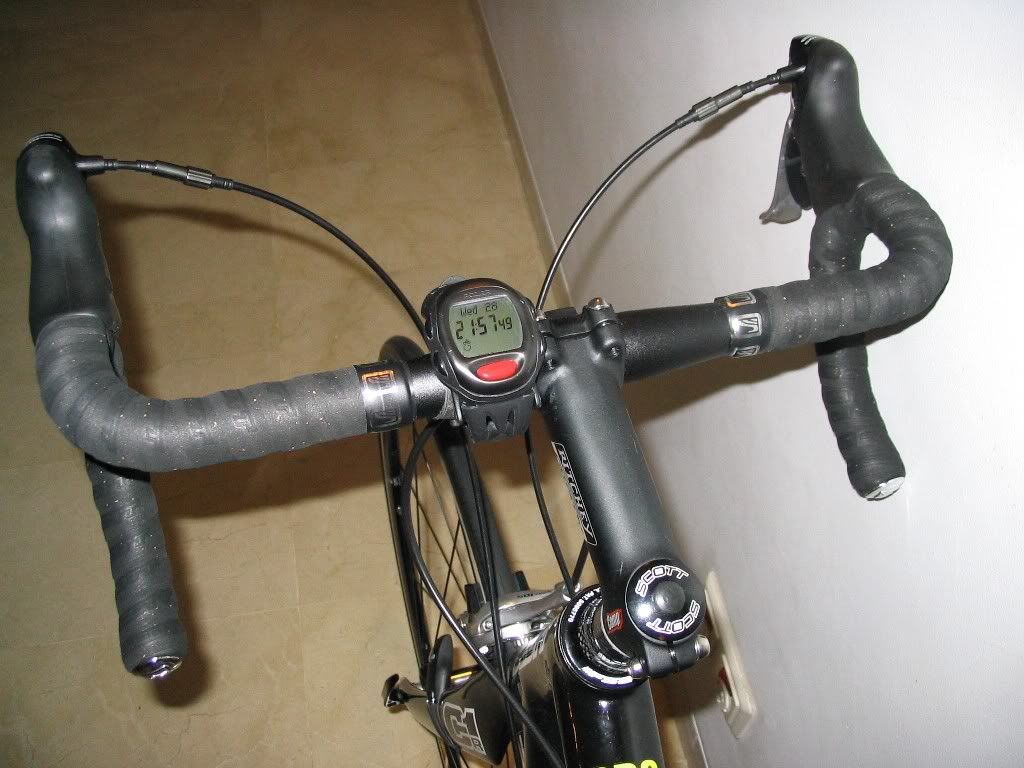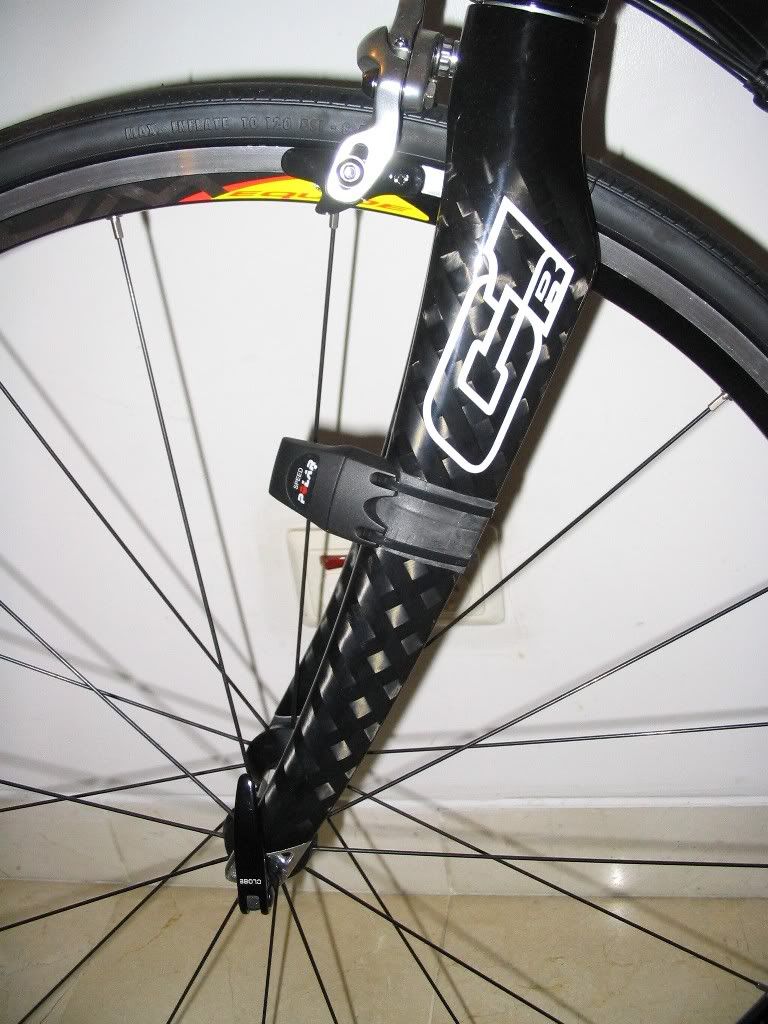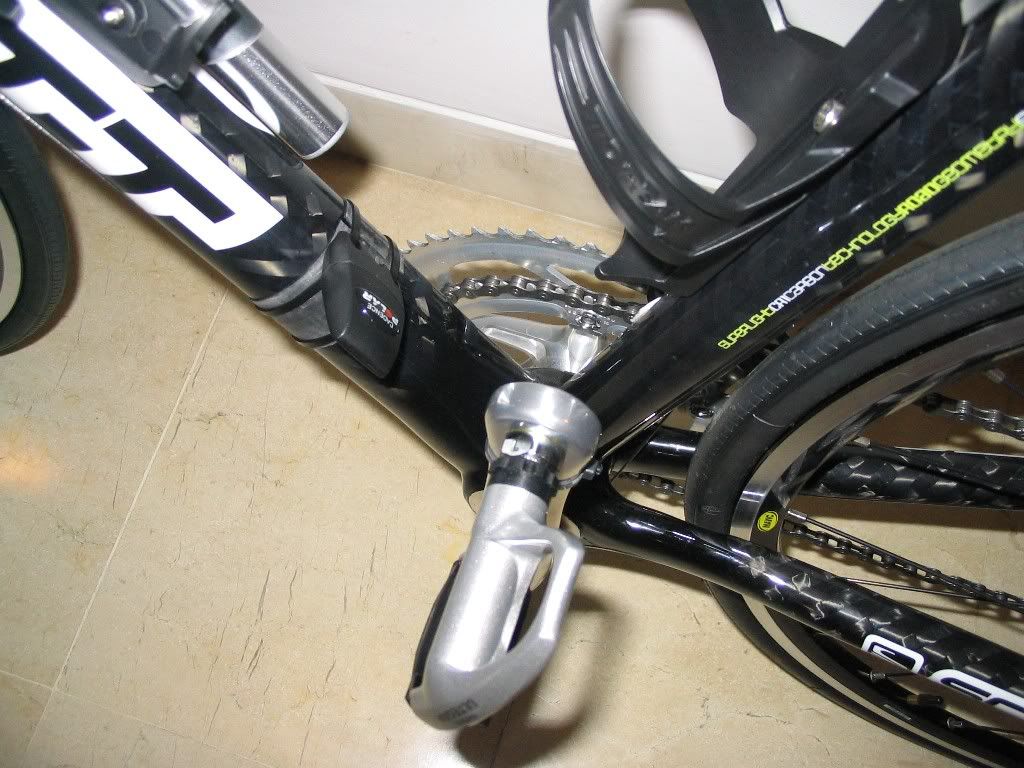
Polar makes speed, cadence and power sensors for the bike so that you can use the same watch (which can be mounted on the handlebar as shown in the picture on the right) to monitor and record your heart rate, speed, cadence, power, etc... Too cool right? First off, I did not get the power sensor (which would negate the speed and cadence sensors) because (1) it is expensive and (2) it can de depressing to know how much power (kW) I am actually putting out compared to the likes of familar things like cars and motobikes. ;)
So I've got the speed and power sensors and found some minor complications when installing them:
- The CR1 is a carbon bike with clear coat on top of the carbon fibres which, according to some forums I read, tend to chip or scratch easier than traditional painted alloy bikes. This means some sort of paint protection is needed before I mount the sensors on the bicycle frame. The CR1 also has a rather different tube profile from the traditional alloy bikes: (a) the top and down tubes are rather FAT (probably to increase rigidity), and (b) the forks have a very cool bladed shape (aerodynamics), both of which makes mounting the sensors at the right angle a bit tricky. After reading and asking many questions, I finally decided to just cut up some old inner tube (courtesy of my local bike shop) and put them between the sensors and the bicycle frame. Probably not the prettiest solution, but hey, it works - protects the paint and gives the sensors good grip on the frame which enables positioning in the needed angles.
- There were some riders who had difficulty getting the sensors to transmit to the watch (which can be mounted on the handle bar). I am not sure if this is due to carbon frames absorbing some of the transmissions, but the guys with carbon bikes seem to have this problem. There is actually a way to increase the transmission power of the sensors and you can find it here, but I am hesistant to do that since it will mean shorter battery life. I found that with some experientation of where to fit the sensor and the angle of the sensor, I can get both the speed and cadence sensors working just fine. Here are some pointers:

(a) Speed sensor - There are two mounting options for this - on one of the front forks for use with the front wheel or on one of the rear chainstays for use with the rear wheel. Some prefer the rear wheel so that the speed sensor can be used with a trainer. I don't have this need since I live in Singapore, so I just chose to mount it on my fork. Even then, the speed sensor needs to be mounted as high up on the fork as possible so that the distance between the sensor and the watch is minimised. Since I do not want to block my nice "CR1" decal, I positioned it just below it (as you can see in the photo on the right). So that's my speed sensor done. (b) Cadence sensor - There are also two mounting options - on the seat tube or the down tube (purely esthetics as far as I can tell). I have a buddy with the CR1 who could not get the sensor working from the seat tube, so I went to the down tube straight off since that is nearer to the watch on the handlebars. Even then, I found that if I mount the sensor pointing down, it cannot reach the watch. The cadence sensor has to be mounted pointing up (as shown in the picture on the right) for the transmission to work.
(b) Cadence sensor - There are also two mounting options - on the seat tube or the down tube (purely esthetics as far as I can tell). I have a buddy with the CR1 who could not get the sensor working from the seat tube, so I went to the down tube straight off since that is nearer to the watch on the handlebars. Even then, I found that if I mount the sensor pointing down, it cannot reach the watch. The cadence sensor has to be mounted pointing up (as shown in the picture on the right) for the transmission to work.
So in short, there are two primary areas to watch for. The first I have not spoken about, which is getting the sensor to sense the magnet Polar provides for the spoke (for speed sensor) or the crank (for cadence sensor). This is relatively easy as there is a small light that blinks each time the magnet is sensed, so just make sure that the cable ties around the sensors are not totally tight and adjust the sensors until they can sense the magnet, then and only then do we tighten the cable ties. The second I spoke about at length above, which is positioning the sensors such that they can reach the watch.



No comments:
Post a Comment